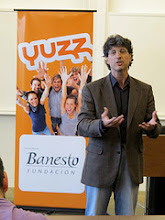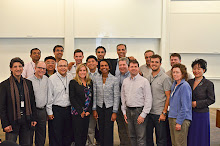Una queridisima ex-alumna que trabaja en el emundo del entertainment me envió ayer un enlace a esta charla en el TEDxRiodelaplata que se hizo en Argentina el 1 de Noviembre de 2011.
http://www.youtube.com/watch?v=_VEYn3bXz34
Hernan Casciari, escritor bohemio, hincha del Racing y Catalan de adopción por amor, cuenta su historia desde que en 2001 montó un blog por soledad que llamó "ORSAI", fuera de juego, al sentirse así entonces: escribía pequeños cuentos, relatos vivenciales que llenaron su blog de seguidores y evangelistas.
Debido al éxito, la industria editorial le contrató para ofrecerle una colaboración profesional: libros, columnas en periódicos, etc. a cambio tenía que dejar el blog para poder vender en el mercado lo que hasta ahora se regalaba. Hernán dejó su blog para dedicarse a ser autor de pago.
Por razones comerciales, sus libros se editaban sólo en España, México y Argentina al no ser negocio hacerlo en Centro América, Bolivia o Paraguay (donde él si tenía lectores y fans).
Las Editoriales y el Periódico (los más grandes del mundo en Castellano) le pagaban a él el 8% del valor de venta mientras el distribuidor se llevaba el 50%; además le robaban, pagándole derechos sobre una fracción de lo vendido, al no tener acceso a las cifras de ventas reales.
Hasta que un día, arrepentido por su decisión mercenaria, ofendido por la explotación sin escrúpulos de los dueños de la cultura escrita, públicamente "les mandó a cagar", volvió a abrir su blog y a tener un contacto directo con sus lectores, utilizando el crowdsourcing para buscar financiación y apoyos que le han llevado a publicar una revista sin publicidad, ORSAI, donde escriben y diseñan grandes autores, desde el pequeño pueblo de Cataluña donde vive y que sus propios lectores distribuyen en todo el mundo; la revista es trimestral pero esperan hacerla bimestral: 6 ediciones al año, 100 gramos de literatura pura, sin publicidad e intereses interpuestos, SIN INTERMEDIARIOS.
La revista se vende por el precio de 15 periódicos en la zona de destino, desde los 16 euros a los 8 dólares,pero AL MISMO TIEMPO también se publica un contenido en pdf en el blog, para aquellos que no quieren o pueden pagarlo.
http://editorialorsai.com/
Lo mas curioso es que para facilitar la distribución de la revista los propios evangelistas de la marca están en contacto y esto ha dado pie a crear un bar en Buenos Aires, ORSAI, lugar de tertulia y vino, también financiado por los propios lectores (un loco ofreció 80,000 dólares para el proyecto, otros pintarlo gratis, ..) y han decidido crear otro bar en Barcelona y otro en México, para triangular cultura hispana, volviendo quizás a las experiencias literarias que hicieron famosos al Café Gijon en Madrid, un slow-drink con Neruda, Márquez y Vargas Llosa.
La historia de Hernán es la historia de todos los creadores que hoy dudan si apoyar al mundo de los "derecho de autor", la ortodoxia que le da algo de comer, a sabiendas que les explotan y roban, o echarse al monte y luchar contra las SOPAs y todas las Leyes SINDE del mundo, entre lo malo conocido y lo bueno por conocer.
Por un lado autores mediocres, famosos pero con las pilas creativas ya descargadas y que no entienden el nuevo mundo digital, tienen todo el interés del mundo en apoyar el "statu quo", cobrando sin ruborizarse dinero que deriva no de sus creaciones, sino de las tasas impuestas sobre los medios informáticos vírgenes (CDs, pen drives, etc.) que recauda una empresa siniestra como la SGAE, con al frente personajes rancios como Batista, con un pie en la cárcel.
Hernán ha demostrado que publicar en pdf el contenido digital de su revista no sólo no quita ventas a sus revistas, sino las aumenta, por el efecto viral; ha entendido que la gente que descarga gratis la revista nunca se la compraría y por lo tanto no le quita nada al autor, haciendo al mismo tiempo un mundo mejor y más culto para todos.
Naturalmente es mucho más fácil empezar nuevos caminos cuando eres un desconocido que cuando eres famoso, al no tener nada que perder, pero sospecho que cada día más autores de verdad seguirán el ejemplo de Hernán y de Alex de la Iglesia: confieso que hasta ahora no había visto ninguna de sus películas pero al ver su ejemplo, las he comprado todas.















